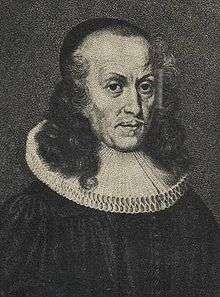Grey Robes
Gråkoltarna (approximately: "Greyfrocks", "The Grey Shirts" or "Grey Robes") was a religious mystic-apocalyptic sect within Radical Pietism, active in Stockholm in Sweden in the 1730s.
Origin
The sect was formed in the residence of Anna Maria van den Aveelen in Södermalm in Stockholm. She was the widow of the artist Johannes van den Aveelen from the Netherlands. She gathered women to meetings of prayer and bible studies. The bible meetings became popular, and attracted more and more people, among them the radical pietist Sven Rosén (Pietist), who formed the bible study group in to a sect.
The congregation of the Gråkoltarna consisted of both sexes, however females had a dominating and leading place. Among the members were members of the noble family Grundelstierna and von Strokirch, the Bryntzenius family as well as among female domestics and wives of soldiers.
Ideology
Gråkoltarna believed in the interpretations of dreams and visions, and their message was that the apocalypse was approaching. Because of this, it was essential to prepare oneself for eternity and make amends for one's sins. The members therefore renounced their possessions and practiced a policy of collective ownership of property. They also renounced work, and everything which could distract them from a spiritual life and what they felt that they had been ordered to do by divinity. Many also chose to live in celibacy. They regarded the luxury consumption and wealth, by that growing in Stockholm because of the flourishing merchant business in Sweden during the Age of liberty, as sinful.
The sect also attracted positive attention and followers outside of Stockholm.
Activity
The sect started to attract attention from the Stockholm authorities in 1731. Many members by that time started to practice charitable work among the poor as a way of their spiritual life. As they had renounced all worldly possessions, they had also adopted the most simply dress possible, and was therefore referred to as Gråkoltarna, "The Grey Shirts". Many of them had adopted this dress after having sold their old clothes and handed out the money among the poor.
Persecution
The sect violated the law of Konventikelplakatet, which banned all religious gatherings outside of the church in order to protect the power of the church. In July 1731, the sect was reported to the authorities by the vicar of the Maria congregation in Stockholm. At the following arrest, nine women and a man by the name Lexelius was arrested: the rest had fled to avoid arrest.
Anna Maria van den Aveelen denied having participated in a sect and claimed that the gatherings had been common gatherings of prayers by the people and guests of her household, and was left with a fine and lectures in how to avoid breaking the laws of the church, as was Lexelius and his wife.
The leading members of the cult were however imprisoned. Among them were Anna Gustafsdotter, Maria Eriksdotter and Elisabet Forsman, who were all placed in Långholmens spinnhus, Stockholm. Anna Gustafsdotter stated that she would never worship the clergy nor submit to anyone except God. They were all imprisoned and sentenced to receive religious instructions. Swedish historian Bengt Sundkler described them as "an apocalyptic-kiliastic pietist movement, the so-called Gråkoltarna [Greyfrocks] in Stockholm of the 1730s" who were "impoverished, destitute Swedes appearing in penitential grey coats".[1]
In prison, the women refused to work, attend religious service, convert back to the church or eat. They caused great concern with their statement that God had not given them permission to work. They were imprisoned in cells deprived of light and heating. One of the "Sisters", Klara Tomasdotter, died during their captivity. Maria Eriksdotter was released in 1736, after having become pregnant with a member of the sect and allowed to marry him, and Forsman returned to her own spouse after this. In 1738, Anna Gustafsdotter, a leading member of the sect, became the last to submit to the church, and was thereby freed.
See also
- Karin Olofsdotter
- Passionsspelen på Stora Bjurum
References
- Swantz, Marja-Liisa. Beyond the Forestline: The Life and Letters of Bengt Sundkler. Gracewing Publishing, 2002. p. 48. ISBN 9780852445600. Retrieved 29 October 2014.
- Nathan Odenvik, "Gråkoltarna – en bild från den pietistiska väckelsen i Sverige under 1700-talet". Stockholm, 1936.
- Artikeln är återgiven med tillstånd från ”Gråkoltarna”. Pietisterna. Arkiverad från originalet den 30 mars 2008.
- Alice Lyttkens: Kvinnan börjar vakna. Den svenska kvinnans historia från 1700 till 1840-talet. Bonniers Stockholm 1976
